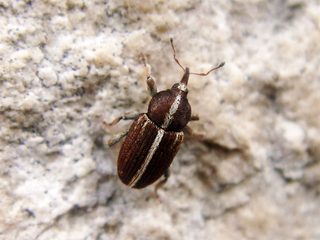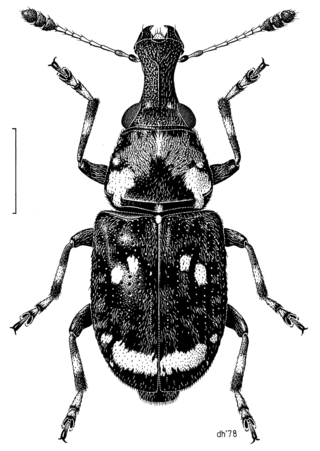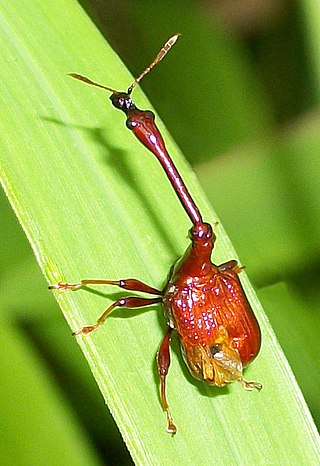
The Curculionidae are a family of weevils, commonly called snout beetles or true weevils. They are one of the largest animal families with 6,800 genera and 83,000 species described worldwide. They are the sister group to the family Brentidae.

The boll weevil is a species of beetle in the family Curculionidae. The boll weevil feeds on cotton buds and flowers. Thought to be native to Central Mexico, it migrated into the United States from Mexico in the late 19th century and had infested all U.S. cotton-growing areas by the 1920s, devastating the industry and the people working in the American South. During the late 20th century, it became a serious pest in South America as well. Since 1978, the Boll Weevil Eradication Program in the U.S. allowed full-scale cultivation to resume in many regions.

Weevils are beetles belonging to the superfamily Curculionoidea, known for their elongated snouts. They are usually small – less than 6 mm in length – and herbivorous. Approximately 97,000 species of weevils are known. They belong to several families, with most of them in the family Curculionidae. It also includes bark beetles, which while morphologically dissimilar to other weevils in lacking the distinctive snout, is a subfamily of Curculionidae. Some other beetles, although not closely related, bear the name "weevil", such as the biscuit weevil, which belongs to the family Ptinidae.

The Kannapolis Cannon Ballers are a Minor League Baseball team of the Carolina League and the Single-A affiliate of the Chicago White Sox. They are located in Kannapolis, North Carolina, and play their home games at Atrium Health Ballpark. The team was established in 1995 as the Piedmont Phillies. From 1996 to 2000, they were known as the Piedmont Boll Weevils. From 2001 to 2019, they were known as the Kannapolis Intimidators, after Kannapolis native NASCAR driver Dale Earnhardt, who was known as "The Intimidator," purchased a share of the team before the 2001 season.

The beetle subfamily Curculioninae is part of the weevil family Curculionidae. It contains over 23,500 described species in 2,200 genera, and is therefore the largest weevil subfamily. Given that the beetle order (Coleoptera) contains about one-quarter of all known organisms, the Curculioninae represent one of the – if not the – most successful radiations of terrestrial Metazoa.
"Credit Where Credit's Due" is the second episode of the first season of the American mystery television series Veronica Mars. Written by series creator Rob Thomas and directed by Mark Piznarski, who also directed the pilot, the episode originally aired on UPN on September 28, 2004.
"The Girl Next Door" is the seventh episode of the first season of the American mystery television series Veronica Mars. Co-written by Jed Seidel and Diane Ruggiero and directed by Nick Marck, the episode premiered on UPN on November 9, 2004.

"Hot Dogs" is the nineteenth episode of the first season of the American mystery television series Veronica Mars. Written by Dayna Lynne North and directed by Nick Marck, the episode originally aired on UPN on April 19, 2005.

"Rashard and Wallace Go to White Castle" is the twelfth episode of the second season of the American television series Veronica Mars, and the thirty-fourth episode overall. Written by John Enbom and directed by John T. Kretchmer, the episode premiered on UPN on February 1, 2006.
Caridae is a small Gondwanan family of weevils. They are considered part of the primitive weevil group, because they have straight rather than geniculate (elbowed) antennae. The insertion of the antennae on the rostrum cannot be seen from above. Caridae also lack spiracles on abdominal tergites 6 and 7. The prothorax lacks lateral carinae. It has been suggested that the fossil weevil Eccoptarthrus belongs in this family, which would result in a change in the family name ; this proposal has been rejected by most coleopterists (e.g.)

Belidae is a family of weevils, called belids or primitive weevils because they have straight antennae, unlike the "true weevils" or Curculionidae which have geniculate (elbowed) antennae. They are sometimes known as "cycad weevils", but this properly refers to a few species from the genera Parallocorynus and Rhopalotria.
"Plan B" is the seventeenth episode of the second season of the American mystery television series Veronica Mars, and the thirty-ninth episode overall. Written by Dayna Lynne North and directed by John T. Kretchmer, the episode premiered on UPN on April 5, 2006.

Brentidae, sometimes known as the primitive weevils, is a cosmopolitan family of primarily xylophagous beetles also known as straight-snouted weevils. The concept of this family has been expanded with the inclusion of three groups formerly placed in the Curculionidae; the subfamilies Apioninae, Cyladinae, and Nanophyinae, as well as the Ithycerinae, previously considered a separate family. They are most diverse in the tropics, but occur throughout the temperate regions of the world. They are among the families of weevils that have non-elbowed antennae, and tend to be elongate and flattened, though there are numerous exceptions.
"President Evil" is the fifth episode of the third season of the American mystery television series Veronica Mars, and the forty-ninth episode overall. Written by Jonathan Moskin and David Mulei and directed by Nick Marck, the episode premiered on The CW on October 31, 2006.

Anthribidae is a family of beetles also known as fungus weevils. The antennae are not elbowed, may occasionally be longer than the body and thread-like, and can be the longest of any members of Curculionoidea. As in the Nemonychidae, the labrum appears as a separate segment to the clypeus, and the maxillary palps are long and projecting.

The Attelabidae is a widespread family of weevils. They are among the primitive weevils, because of their straight antennae, which are inserted near the base of the rostrum. The prothorax is much narrower than the base of the elytra on the abdomen. Attelabidae and the related family Rhynchitidae are known commonly as the leaf-rolling weevils. Rhynchitidae may be treated as subfamily Rhynchitinae of the Attelabidae.
"Weevils Wobble But They Don't Go Down" is the nineteenth and penultimate episode of the third season of the American mystery television series Veronica Mars, and the 63rd episode overall. Written by Phil Klemmer and directed by Jason Bloom, the episode premiered on The CW on May 22, 2007. The series depicts the adventures of Veronica Mars as she deals with life as a college student while moonlighting as a private detective.
Elwood Curtin Zimmerman was an American entomologist best known for his two multivolume series: Insects of Hawaii published by the University of Hawaiʻi Press and Australian Weevils published by Australia's CSIRO.

Rhynchophorus, or common name palm weevils, is a genus of beetles in the weevil family, Curculionidae. Palm weevils are major pests of various trees in the family Arecaceae throughout the tropics including: coconut, Areca catechu, species of the genus Phoenix, and Metroxylon sagu. Two species are invasive pests outside their native ranges, Rhynchophorus ferrugineus and Rhynchophorus palmarum.

Cryptorhynchus lapathi is a species of weevil native to Europe. Its common names include poplar and willow borer, osier weevil, and willow weevil.












